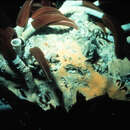fr
noms dans le fil d’Ariane


In 1914, the French biologist Maurice Caullery described a long, slender tube-dwelling worm that had been collected in Indonesia around 1900 during the Dutch Siboga expedition. He erected both a new genus, Siboglinum, and a new family, Siboglinidae, for this unusual gutless worm (Caullery 1914, cited in McHugh 1997 and Pleijel et al. 2009). In 1951, Siboglinum was placed by Ivanov in the then recognized phylum Pogonophora (Ivanov 1951, cited in Pleijel et al. 2009). In 1995, phylogenetic analyses by Rouse and Fauchald led them to conclude that (pogonophorans + vestimentiferans) should possibly be united as a single, family level taxon within the polychaete annelids. They suggested reverting to the name Lamellisabellidae for this family (from Uschakov 1933, cited in Pleijel et al. 2009), but later recognized that the name Siboglinidae preceded their proposed name and should be used instead (Rouse and Fauchald 1997). McHugh (1997) also concluded that the pogonophorans (including the vestimentiferans) should be placed together within Caullery's family Siboglinidae. Pleijel et al. (2009) trace in great detail the historical taxonomic and nomenclatural treatment of the group of worms now treated as the Siboglinidae.